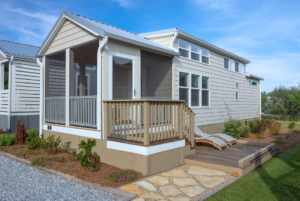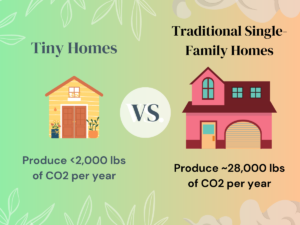The concept of living in small spaces isn’t new. In fact, it has been around since the beginning of human history – though it was only recently that tiny homes found their way into the mainstream. The housing crisis in 2008, coupled with the growing popularity of sustainability and minimalist living, played a significant role in sparking what we would call the “tiny home movement”: the popularization of homes that encompass 400 square feet or less. Even today, tiny homes continue to increase in popularity for their affordability, trendiness, and positive environmental impact.
Amidst its popularity, many tiny home communities have sprung up across the U.S., including our North Carolina communities: The Hamlet and The Village. These communities tend to have a smaller overall carbon footprint, attracting the attention of those looking to be more environmentally friendly in everyday life.
Reduce Your Carbon Footprint in a Tiny Home
In order to understand the environmental impact of tiny homes, it’s key to understand what your carbon footprint is. Your carbon footprint is the total greenhouse gas emissions that come from your choice in products as a consumer and your lifestyle. To have as little environmental impact as possible, you should aim to have as low of a carbon footprint as possible – a goal that has become an achievable reality with tiny homes.
As evident by their smaller size, tiny homes use fewer materials to build. They require less lumber, concrete, insulation, roofing materials, and other construction materials compared to traditional homes. This reduction in material consumption helps conserve natural resources and decreases the energy required for manufacturing and transportation. The opposite is also true: the more materials used in the construction of a home, the more energy is used and greenhouse gases emitted.
While it’s difficult to pinpoint exactly the number of tons of CO2 produced in the construction of a home (sources estimate it’s anywhere between 16,000 – 28,000 lbs), we do know that houses require a multitude of materials to build: concrete, glass, various metals, lumber, etc. The larger the home, the more materials they use. Per the U.S. Census Bureau, the average size of a new single-family home sold in 2022 was 2,383 square feet – a whopping 63% larger than the average American home 50 years ago.
To put the environmental impact of these materials into context: According to an article published on the MIT Climate Portal, the creation of concrete is responsible for 7% of the planet’s greenhouse gas emissions, while the iron and steel industry produces around 11%. In this case, bigger homes are definitely not better!
Tiny Homes Go Big on Energy Efficiency
Considering environmental impact, tiny homes require less materials and energy to build than traditional single-family homes – but did you know they require less energy to maintain, too? Electricity is often generated by burning fossil fuels. By maximizing the efficiency of your energy usage, it decreases the negative impact you have on the environment.
Unfortunately, many residential HVAC systems are not efficient. Residential power, heating, and cooling accounts for about 20% of all greenhouse gas emissions in the United States. Some homes are even so big that they require multiple units, effectively doubling the negative impact of these systems and – you guessed it – increasing your carbon footprint.
On the other hand, tiny homes have less space that needs to be heated or cooled. Heating and cooling are among the most energy-intensive processes in a home, so by decreasing the area in a home to condition, less energy is used. With proper insulation, tiny homes can also retain heat or cool air more effectively, reducing the need for continuous heating or cooling. This helps conserve energy and decreases the associated carbon emissions.
Environmental Benefits of Downsizing
Downsizing to a tiny home goes hand-in-hand with adopting a more sustainable, simple lifestyle. The fact is, you’ll have less space to work with in a tiny home. Furniture, belongings, décor, and everything in-between will need to shrink in size and quantity to fit inside a 400 square-foot home. This often sparks attention to one’s consumption patterns, with emphasis on prioritizing experiences over material possessions, focusing on what truly adds value to their lives.
This positive shift in mindset encourages sustainable choices: buying second-hand, repairing items instead of replacing them, and supporting local and sustainable products and services, to name a few. By consuming less material goods, you reduce the overall environmental impact associated with the production, transportation, and disposal of said goods.
These facts tell us that tiny homes offer a modern, compelling solution to the environmental challenges we face today. With their reduced space and energy-efficient design, these homes help reduce your carbon footprint and protect the environment. By requiring less building materials, heating and cooling, and promoting minimalist lifestyles, tiny homes embody sustainability at its core. Living in a tiny home is not just a lifestyle choice – it is a conscious decision to reduce your environmental impact and contribute to a more sustainable world.
If you’re ready to downsize and explore how you can reduce your carbon footprint, we have a variety of beautiful tiny homes available at The Hamlet. Aside from having reduced carbon emissions from tiny homes, our community promotes sustainability through our garden envoys. On our property, you can find flourishing vegetable gardens, a designated space for composting, and like-minded people enjoying the simple life.





